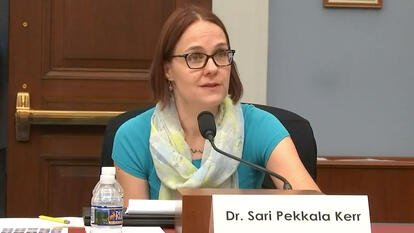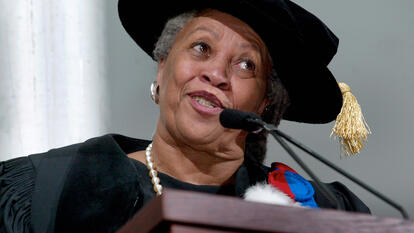New Issue of “Wellesley” Magazine Focuses on the College Community’s Efforts to Protect the Environment

The fall issue of Wellesley magazine lands in mailboxes this week, and its contents have a decidedly green tint: The articles highlight the work of students, alumnae, and faculty to preserve and protect the environment.
As editor Alice Hummer explained in her introduction to the issue, we live in a tumultuous time where angry voices, often spewing hate and untruths, seem to dominate social media. Yet, she wrote, “a single voice can give hope and bring solace. A single voice, joined with others, can help to bring needed change. All of which is a long way of explaining why we chose to do this special ‘green’ issue.”
The article Hope in Action, for example, by Jennifer McFarland Flint, features five alumnae who are environmental activists working for change in various settings. Elizabeth Burakowski ’03, pictured in the cartoon above, recalled many happy days skiing in New Hampshire, where she spent much of her childhood. Yet when the temperature reached 60 degrees Fahrenheit one Christmas, Burakowski knew something was wrong. She began researching climate change, which led her to pursue a master’s and doctorate from the University of New Hampshire.
Today, she is a research assistant professor at the Institute for the Study of Earth, Oceans, and Space at the University of New Hampshire in Durham and the mother of a 3-year-old boy who is a “snowman superfan.”
“When he’s in his 80s, will he still have a white winter in New Hampshire to share with his grandkids? It’s a distinct possibility that he won’t,” Burakowski said. “But if we continue along a trajectory of reducing carbon emissions instead of increasing them, we can slow this train down.”
The sense of optimism that drives Burakowski’s work is shared by the other alumnae mentioned in the piece, including Liza Bemis ’03, who earned a master’s degree in the agriculture, food, and environment program at the Tufts Friedman School of Nutrition Science and Policy. Since 2011, she has managed the retail operations of her family’s organic farm in Concord, Mass. “This land isn’t mine or even ours, we happen to be making decisions for it right now,” Bemis said. “We can so quickly see the effects of our work on the land and the environment—the birds, coyotes, deer, all the insects, trees, and systems are impacted by our farming choices.”
Artist Hoi-Fei Mok ’10, a program officer at ICLEI, a nonprofit that supports cities and towns working to implement climate action, was recently selected by the city of San Leandro, Calif., to transform the exterior of a utility box into a work of art. Mok’s display features bees inside a honeycomb, with the words “You’ll miss me when I’m gone” on one side and “Because we’re in this together” on the other.
“Art can help us envision a future where we all have access to clean energy, food and water, safe homes, and inclusive communities. I see all of this as interconnected,” said Mok, who earned a Ph.D. in environmental science at the University of Melbourne in Australia. “A lot of my work is determined by relationship building: It’s key to building a strong social fabric, which is what will make us more resilient in the face of something like climate change.”
That message is repeated elsewhere in the magazine, as is the idea that one person can inspire change, and many people, working together, can create a much greener future.
The entire fall issue as well as previous issues of Wellesley can be read online.



